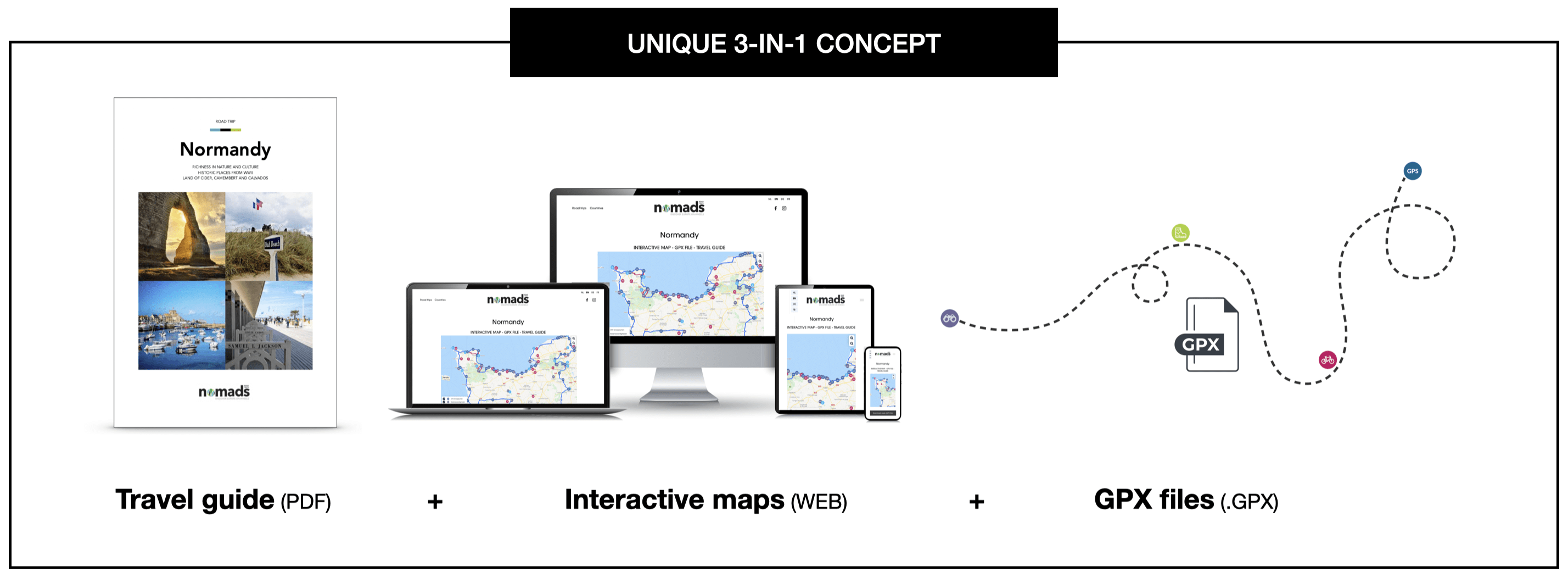
Normandy
This 957km road trip through the French province of Normandy starts in Dieppe and follows the chalk cliffs of the Côte d'Albâtre past Etretat and Le Havre to the picturesque port towns of Honfleur and Deauville. This is followed by a tour of 'invasion beaches' to commemorate the Normandy landings on 6 June 1944. The route continues across the Cotentin peninsula to the monumental Mont-Saint-Michel. The return journey takes us through the natural beauty of 'Suisse Normande', past Rouen and the Seine Valley until we return to Dieppe.
Highlights along the way are the chalk cliffs of Etretat, the drive across the Pont de Normandie, a visit to Honfleur and Deauville, the invasion beaches of WWII, the fishing villages Saint-Vaast and Barfleur, Mont Saint-Michel, La Roche d'Oëtre in Suisse Normande and the abbey of Jumièges in the Seine Valley.
- Perfect travel companion if you want to discover Normandy with a campervan, car or motorbike
- Clearly laid out in 7 stages, with 44 places of interest, travel tips, 23 walking routes, 32 cycle routes, local tourist offices and overnight accommodation (90 campsites and 40 motorhome sites)
- Available as a PDF (travel guide 73 pages) in beautiful design, illustrated with inspiring texts and high quality photography
- Includes interactive map for PC, tablet or smartphone so you have all the information at hand when you're on the road
- Includes GPX files so you can download the full route and all cycling and walking routes onto your GPS
Read the first chapter

Some highlights on this road trip

Dieppe - Etretat
The Côte d'Albâtre between Dieppe and Etretat is a chain of chalk cliffs and the cradle of Impressionism. Painters such as Monet were impressed by the incomparable light and changing skies, the turquoise colour of the lively water and the changing landscape behind the coastline.
Final destination of this stage is Etretat, an old fishing village and once the first seaside resort in France. It stretches between two high cliffs or hollow chalk cliffs created by erosion. The beautiful beaches on the impressive cliffs, the nice boulevard and the green area on top of the chalk cliffs are worth a visit. Etretat is at its most beautiful at sunset, when the red sunlight reflects on the chalk cliffs, creating a breathtaking sight.

Etretat - Deauville
From Etretat, we set sail for the mouth of the Seine. The majority of travellers pass by Le Havre and rush over the impressive Pont de Normandie to the Côte Fleurie where charming and chic seaside resorts such as Honfleur and Deauville can be found. A shame, because a stop in Le Havre is worthwhile and under the Pont de Normandie lies a beautiful nature reserve with exceptional fauna and flora. In Le Havre, you can see all the highlights on one city tour, such as the 'Eglise Saint-Joseph' (a bit of New York in Le Havre) and Musée Malraux, the centre for impressionism in Normandy.
Across the Seine awaits Honfleur, a charming seaside resort with a picturesque harbour and medieval centre. You do not necessarily have to linger in the village itself, because just outside Honfleur, there is a lot of natural beauty to discover.

Deauville - Omaha Beach
Deauville is a chic seaside resort, best known for its unique wooden walkway on the beach. It shares a port with the neighbouring Trouville-sur-Mer, where you can enjoy a delicious meal at the fish market. Once we pass Ouistreham and the mouth of the river Orne, we land in historic territory. Sword Beach, Juno Beach, Gold Beach and Omaha Beach are vivid reminders of the Normandy landings on 6 June 1944, better known as D-Day. This entire region is an almost open-air museum where numerous monuments and museums guard the memory of the invasion on the beaches.
Who wants to take some distance from the violence of war, can indulge in culture in Bayeux. It houses the world-famous, 70-metre-long Bayeux Tapestry, which depicts the conquest of England in 1066 by William, Duke of Normandy.

Omaha Beach - Cherbourg
After Omaha Beach, we stay in the atmosphere of WWII for a while. At La Pointe du Hoc, you learn all about perhaps the most heroic deed of D-Day: the climbing of this 30-metre high chalk cliff by 39 American Rangers in order to defuse the German guns. The route continues through the Marais du Cotentin et du Bessin Nature Reserve until we reach the invasion beach of Utah Beach.
Further along the route, we pass the fishing villages of Saint-Vaast and Barfleur, both proclaimed 'Un des plus beaux villages de France'. They are known for their excellent oysters and mussels. We are gradually approaching the head of the Cotentin peninsula. We rounded it off at the Gatteville lighthouse and set course along the sea to Cherbourg.

